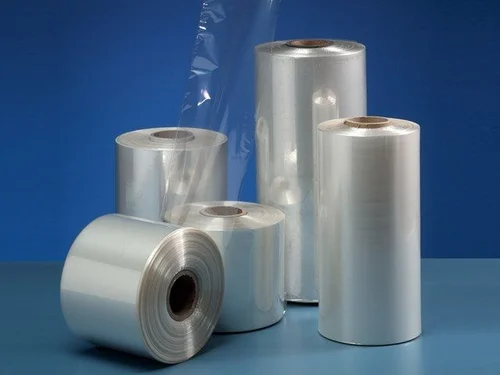Shrink Films for Packaging: A Comprehensive Guide

In the dynamic world of packaging, innovation is key to ensuring product protection, enhancing shelf appeal, and optimizing logistics. Among the various packaging solutions available, shrink films for packaging have emerged as a versatile and widely adopted method. This blog post delves into the world of shrink films, exploring their types, applications, benefits, and considerations for businesses looking to enhance their packaging strategies.
What are Shrink Films?
Shrink films are polymer-based materials that, when heat is applied, shrink tightly over the product they are covering. This process creates a secure, form-fitting layer that protects the contents from various external factors such as moisture, dust, and tampering. The result is a clean, professional, and often tamper-evident package.
Types of Shrink Films
Several types of shrink films cater to different packaging needs, each with unique properties:
· Polyolefin (POF): Known for its high clarity, strength, and versatility, POF is a popular choice for various applications, including food packaging. It’s also FDA-approved for food contact, making it a safe option for consumable goods.
· Polyvinyl Chloride (PVC): While once a dominant material, PVC has seen a decline due to environmental concerns. However, it’s still used in some industrial applications due to its cost-effectiveness. It’s crucial to ensure proper ventilation when using PVC due to potential fumes during the shrinking process.
· Polyethylene (PE): This is a widely used material in various forms, including shrink film. PE shrink films are known for their durability and flexibility, making them suitable for bundling multiple items or packaging heavier products.
Applications of Shrink Films
The versatility of shrink films for packaging is evident in their wide range of applications across industries:
· Food and Beverage: From wrapping individual food items to bundling multipacks of beverages, shrink films provide protection and maintain product freshness.
· Retail Packaging: Shrink films enhance the shelf appeal of products by providing a glossy, clear finish. They are used for packaging toys, electronics, and various consumer goods.
· Industrial Packaging: For securing and protecting industrial goods during transport and storage, shrink films offer a robust and cost-effective solution. They are used for bundling pipes, lumber, and other construction materials.
· Pharmaceuticals: Shrink films provide tamper-evident packaging for pharmaceuticals, ensuring product integrity and safety.
Benefits of Using Shrink Films for Packaging
The popularity of shrink films for packaging stems from the numerous benefits they offer:
· Product Protection: Shrink films create a protective barrier against moisture, dust, dirt, and other contaminants, preserving product quality and extending shelf life.
· Enhanced Shelf Appeal: The tight, glossy finish of shrink films enhances product presentation, making them more attractive to consumers on the retail shelf.
· Tamper Evidence: Shrink-wrapped packages provide clear evidence of tampering, ensuring product safety and building consumer trust.
· Cost-Effectiveness: Compared to other packaging methods, shrink films offer a cost-effective solution, especially for high-volume applications.
· Versatility: Shrink films can conform to various shapes and sizes, making them suitable for packaging a wide range of products.
· Efficient Packaging Process: Shrink wrapping can be automated, leading to increased packaging efficiency and reduced labor costs.
Considerations When Choosing Shrink Films
While shrink films for packaging offer numerous advantages, several factors should be considered when selecting the right type for your needs:
· Type of Product: The nature of the product being packaged will determine the appropriate type of shrink film. For instance, food products require FDA-approved materials like POF.
· Thickness and Strength: The required thickness and strength of the film will depend on the weight and fragility of the product.
· Shrink Ratio: This refers to the percentage by which the film shrinks when heat is applied. It’s crucial to choose a shrink ratio that provides a tight fit without distorting the product.
· Clarity and Gloss: For retail applications, high clarity and gloss are essential to enhance product visibility and appeal.
· Environmental Impact: Consider the recyclability and environmental impact of the chosen shrink film. Opting for more sustainable options like thinner films or recyclable materials can contribute to environmental responsibility.
· Equipment and Application Process: Ensure you have the appropriate equipment, such as heat guns or shrink tunnels, for applying the shrink film effectively.
The Future of Shrink Films
The field of shrink films for packaging continues to evolve, with ongoing research and development focused on:
· Sustainable Materials: There’s a growing emphasis on developing more sustainable shrink films using biodegradable or recyclable materials.
· Enhanced Performance: Innovations are aimed at improving the strength, clarity, and shrink properties of films.
· Advanced Application Technologies: Automation and advanced shrinking technologies are being developed to further enhance packaging efficiency.
Conclusion
Shrink films for packaging have become an indispensable tool for businesses across various industries. Their versatility, cost-effectiveness, and numerous benefits make them a compelling choice for enhancing product protection, presentation, and overall packaging efficiency. By carefully considering the different types of shrink films available and their specific applications, businesses can leverage this technology to optimize their packaging strategies and achieve their business objectives.




